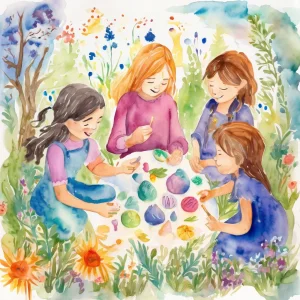Activity
Similar Activities
Whimsical Collage Creations: A Colorful Adventure
Children’s Age: 2–2.5 years
Activity Duration: 5 – 10 minutes
"Colorful Collage Creations" is a creative activity designed for children aged 24 to 30 months to enhance cognitive skills, communication abilities, and creativity. With colored pa…
Activity Duration: 5 – 10 minutes
Nature-Inspired Playdough Sculpting: Creative Nature Explorations
Children’s Age: 3–4 years
Activity Duration: 5 – 15 minutes
Children will enjoy a nature-inspired playdough sculpting activity designed to boost creativity, fine motor skills, and communication. Simply gather homemade playdough, nature item…
Activity Duration: 5 – 15 minutes
Shape Discovery Adventure: Shape Sorting and Matching
Children’s Age: 2–2.5 years
Activity Duration: 10 minutes
This shape sorting and matching activity is designed for children aged 24 to 30 months to enhance their cognitive skills through shape recognition and matching. Using colorful cons…
Activity Duration: 10 minutes
Around the World Postcard Adventure: Global Tales
Children’s Age: 3–6 years
Activity Duration: 20 minutes
Embark on the "Around the World Postcard Adventure" to explore diverse countries and cultures through creative writing and art! Gather postcards, art supplies, and books about diff…
Activity Duration: 20 minutes
Nature-Inspired Drawing Activity
Children’s Age: 8–9 years
Activity Duration: 10 – 25 minutes
An outdoor activity where children draw natural elements to foster creativity and ecological awareness.
Activity Duration: 10 – 25 minutes
Picnic Adventure: Pretend Cooking Play for Toddlers
Children’s Age: 2–3 years
Activity Duration: 10 – 30 minutes
An imaginative activity where children (ages 2-3) engage in pretend cooking during a picnic adventure.
Activity Duration: 10 – 30 minutes
Nature Shapes Adventure: Bird Watch & Scavenger Hunt
Children’s Age: 4–5 years
Activity Duration: 10 minutes
An outdoor activity for children aged 4-5 years combining bird watching and shape recognition.
Activity Duration: 10 minutes
Digital Beats and Hoop Dreams Coding Adventure
Children’s Age: 9–12 years
Activity Duration: 10 – 20 minutes
An engaging coding activity integrating music production, basketball skills, and teamwork for children aged 9-12 years.
Activity Duration: 10 – 20 minutes
Cultural Creatures: Stop-Motion Animation Adventure
Children’s Age: 4–9 years
Activity Duration: 10 – 25 minutes
An interactive activity using technology to create stop-motion animations exploring plants and animals from diverse cultures.
Activity Duration: 10 – 25 minutes
Musical Freeze Painting: A Creative Dance Adventure
Children’s Age: 3 years
Activity Duration: 10 – 20 minutes
An engaging activity combining painting with musical freeze dance to promote creativity and play skills.
Activity Duration: 10 – 20 minutes
Shadow Hunt and Solar Exploration
Children’s Age: 5–6 years
Activity Duration: 10 – 30 minutes
An activity combining Physics, Space, and Ecological Awareness for children aged 5-6 to explore shadows and solar energy.
Activity Duration: 10 – 30 minutes
Nature Scavenger Hunt: Adventure in the Wild
Children’s Age: 4–9 years
Activity Duration: 10 minutes
An outdoor, nature-based activity promoting ecological awareness and cognitive development in children aged 4-9 years.
Activity Duration: 10 minutes




























